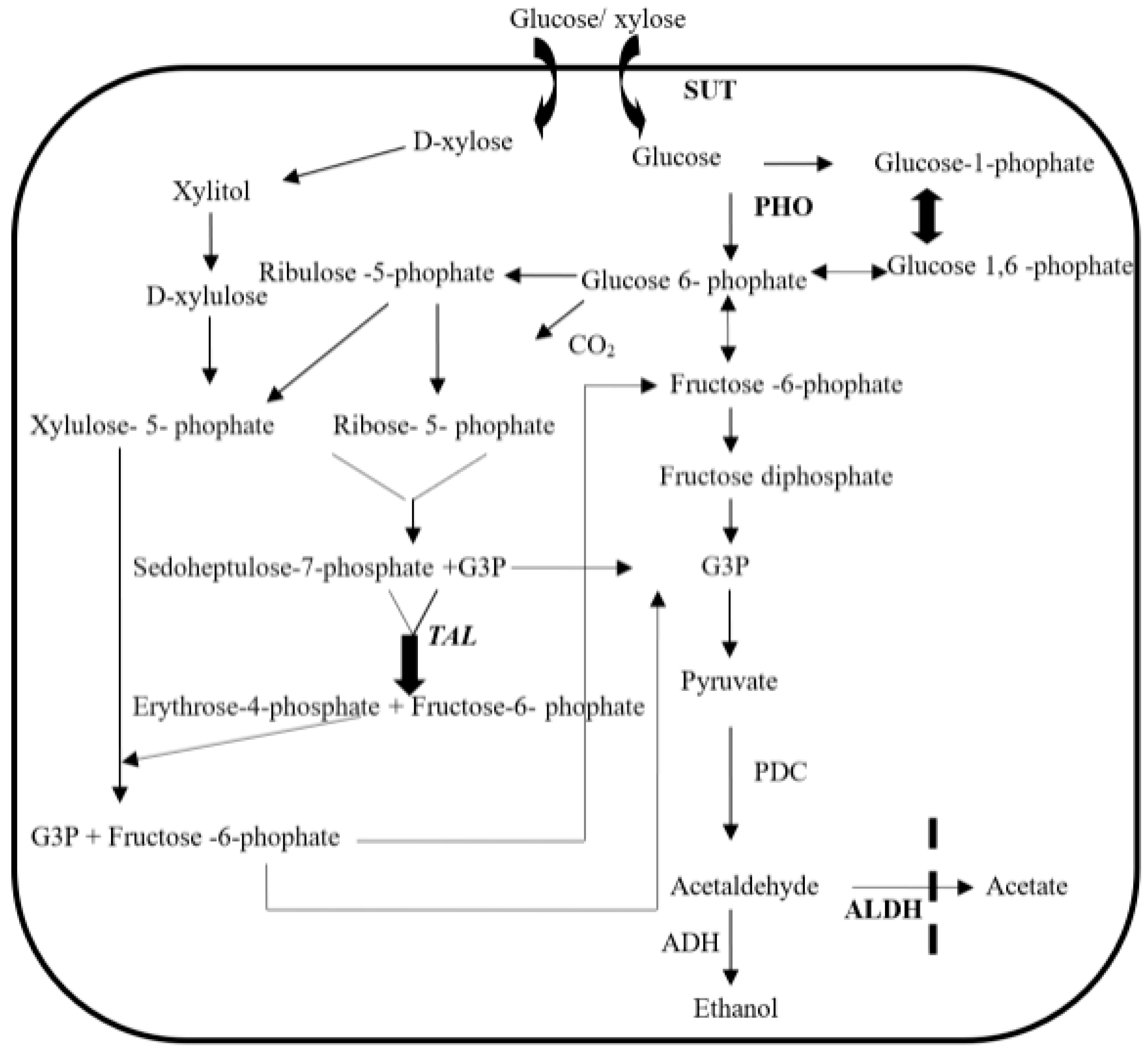Knockout of the Aldehyde Dehydrogenase Gene in Fusarium oxysporum for Enhanced Ethanol Yield
Abstract
1. Introduction
2. Materials and Methods
2.1. Strains, Plasmids, and Growth Conditions
2.2. Cloning and Bioinformation Analysis of the aldh Gene
2.3. Construction of Homogenous Recombinant Plasmid and Transformation
2.4. Agrobacterium Tumefaciens-Mediated Transformation and Screening of Fungal Mutants
2.5. Genetic Stability of Transformants
2.6. Fermentation Conditions
2.7. Analytical Methods
3. Results and Discussion
3.1. Cloning and Sequence Analysis of aldh
3.2. Disruption of aldh in F. oxysporum
3.3. Sensitivity of the Mutants to Hygromycin and Their Mitotic Stability
3.4. Fermentation on Single-Sugar Medium
4. Conclusions
Supplementary Materials
Author Contributions
Funding
Data Availability Statement
Conflicts of Interest
References
- Liu, C.; Sun, Y.; Yang, F.; Liu, J. Effect of solar irradiance on photo biochemical transformation process of direct absorption methane digester. Energy Convers. Manag. 2018, 172, 173–181. [Google Scholar] [CrossRef]
- Singhvi, M.S.; Deshmukh, A.R.; Kim, B.S. Cellulase mimicking nanomaterial-assisted cellulose hydrolysis for enhanced bioethanol fermentation: An emerging sustainable approach. Green Chem. 2021, 23, 5064–5081. [Google Scholar] [CrossRef]
- Rajak, R.C.; Saha, P.; Singhvi, M.; Kwak, D.; Kim, D.; Lee, H.; Deshmukh, A.R.; Bu, Y.; Kim, B.S. An eco-friendly biomass pretreatment strategy utilizing reusable enzyme mimicking nanoparticles for lignin depolymerization and biofuel production. Green Chem. 2021, 23, 5584–5599. [Google Scholar] [CrossRef]
- Fu, Y.; Wu, P.; Xue, J.; Zhang, M.; Wei, X. Cosmosporasides F–H, three new sugar alcohol conjugated acyclic sesquiterpenes from a Fusarium oxysporum fungus. Nat. Prod. Res. 2022, 36, 3420–3428. [Google Scholar] [CrossRef]
- Ibrahim, S.R.M.; Sirwi, A.; Eid, B.G.; Mohamed, S.G.A.; Mohamed, G.A. Bright Side of Fusarium oxysporum: Secondary Metabolites Bioactivities and Industrial Relevance in Biotechnology and Nanotechnology. J. Fungi 2021, 7, 943. [Google Scholar] [CrossRef]
- Nugent, B.; Ali, S.S.; Mullins, E.; Doohan, F.M. A Major Facilitator Superfamily Peptide Transporter from Fusarium oxysporum Influences Bioethanol Production From Lignocellulosic Material. Front. Microbiol. 2019, 10, 295. [Google Scholar] [CrossRef]
- Garzon, N.; Laure, H.J.; Rosa, J.C.; Cabral, H. Fusarium oxysporum cultured with complex nitrogen sources can degrade agricultural residues: Evidence from analysis of secreted enzymes and intracellular proteome. Renew. Energy 2018, 133, 941–950. [Google Scholar] [CrossRef]
- Panagiotou, G.; Christakopoulos, P.; Villas-Boas, S.; Olsson, L. Fermentation performance and intracellular metabolite profiling of Fusarium oxysporum cultivated on a glucose–xylose mixture. Enzym. Microb. Technol. 2005, 36, 100–106. [Google Scholar] [CrossRef]
- M’Barek, H.N.; Arif, S.; Taidi, B.; Hajjaj, H. Consolidated bioethanol production from olive mill waste: Wood-decay fungi from central Morocco as promising decomposition and fermentation biocatalysts. Biotechnol. Rep. 2020, 28, e00541. [Google Scholar] [CrossRef]
- Ali, S.S.; Nugent, B.; Mullins, E.; Doohan, F.M. Insights from the Fungus Fusarium oxysporum Point to High Affinity Glucose Transporters as Targets for Enhancing Ethanol Production from Lignocellulose. PLoS ONE 2013, 8, e54701. [Google Scholar] [CrossRef][Green Version]
- Fan, J.X.; Yang, Q.; Liu, Z.H.; Huang, X.M.; Song, J.Z.; Chen, Z.X.; Sun, Y.; Liang, Q.; Wang, S. The characterization of transaldolase genetal from Pichia stipitis and its heterologous expression in Fusarium oxysporum. Mol. Biol. Rep. 2011, 38, 1831–1840. [Google Scholar] [CrossRef] [PubMed]
- Fan, J.-X.; Yang, X.-X.; Song, J.-Z.; Huang, X.-M.; Cheng, Z.-X.; Yao, L.; Juba, O.S.; Liang, Q.; Yang, Q.; Odeph, M.; et al. Heterologous Expression of Transaldolase Gene Tal from Saccharomyces cerevisiae in Fusarium oxysporum for Enhanced Bioethanol Production. Appl. Biochem. Biotechnol. 2011, 164, 1023–1036. [Google Scholar] [CrossRef] [PubMed]
- Anasontzis, G.E.; Kourtoglou, E.; Mamma, D.; Villas-Boâs, S.G.; Hatzinikolaou, D.G.; Christakopoulos, P. Constitutive homologous expression of phosphoglucomutase and transaldolase increases the metabolic flux of Fusarium oxysporum. Microb. Cell Factories 2014, 13, 43. [Google Scholar] [CrossRef]
- Peng, H.; Wu, G.; Shao, W. The aldehyde/alcohol dehydrogenase (AdhE) in relation to the ethanol formation in Thermoanaerobacter ethanolicus JW200. Anaerobe 2008, 14, 125–127. [Google Scholar] [CrossRef] [PubMed]
- Cao, Y.; Liao, L.; Xu, X.-W.; Oren, A.; Wu, M. Aldehyde dehydrogenase of the haloalkaliphilic archaeon Natronomonas pharaonis and its function in ethanol metabolism. Extremophiles 2008, 12, 849–854. [Google Scholar] [CrossRef] [PubMed]
- Flipphi, M.; Mathieu, M.; Cirpus, I.; Panozzo, C.; Felenbok, B. Regulation of the Aldehyde Dehydrogenase Gene (aldA) and Its Role in the Control of the Coinducer Level Necessary for Induction of the Ethanol Utilization Pathway in Aspergillus nidulans. J. Biol. Chem. 2001, 276, 6950–6958. [Google Scholar] [CrossRef] [PubMed]
- Remize, F.; Andrieu, E.; Dequin, S. Engineering of the Pyruvate Dehydrogenase Bypass in Saccharomyces cerevisiae: Role of the Cytosolic Mg2+ and Mitochondrial K+ Acetaldehyde Dehydrogenases Ald6p and Ald4p in Acetate Formation during Alcoholic Fermentation. Appl. Environ. Microbiol. 2000, 66, 3151–3159. [Google Scholar] [CrossRef] [PubMed]
- Wang, X.; Mann, C.J.; Bai, Y.; Ni, L.; Weiner, H. Molecular cloning, characterization, and potential roles of cytosolic and mi-tochondrial aldehyde dehydrogenases in ethanol metabolism in Saccharomyces cerevisiae. J. Bacteril. 1998, 180, 822–830. [Google Scholar] [CrossRef]
- Lu, X.H.; Wang, D.L.; Fu, L.; Zhao, C.S. Gene deletion to decrease acetic acid of Saccharomyces cerevisiaes. Liquor. Mak. Sci. Technol. 2007, 3, 41–44. [Google Scholar]
- Staben, C.; Jensen, B.; Singer, M.; Pollock, J.; Schechtman, M.; Kinsey, J.; Selker, E. Use of a bacterial hygromycin B resistance gene as a dominant selectable marker in Neurospora crassa transformation. Fungal Genet. Newsl. 1989, 36, 79–81. [Google Scholar] [CrossRef]
- Gardiner, D.M.; Howlett, B.J. Negative selection using thymidine kinase increases the efficiency of recovery of transformants with targeted genes in the filamentous fungus Leptosphaeria maculans. Curr. Genet. 2004, 45, 249–255. [Google Scholar] [CrossRef] [PubMed]
- Jyothishwaran, G.; Kotresha, D.; Selvaraj, T.; Srideshikan, S.; Rajvanshi, P.; Jayabaskaran, C. A modified freeze–thaw method for efficient transformation of Agrobacterium tumefaciens. Curr. Sci. 2007, 93, 770–772. Available online: https://www.currentscience.ac.in/Volumes/93/06/0770.pdf (accessed on 26 December 2022).
- Covert, S.F.; Kapoora, P.; Holeea, M.; Brileya, A.; Nairn, C.J. Agrobacterium tumefaciens-mediated transformation of Fusarium circinatum. Mycol. Res. 2001, 105, 259–264. [Google Scholar] [CrossRef]
- Karakousis, A.; Tan, L.; Ellis, D.; Alexiou, H.; Wormald, P. An assessment of the efficiency of fungal DNA extraction methods for maximizing the detection of medically important fungi using PCR. J. Microbiol. Methods 2006, 65, 38–48. [Google Scholar] [CrossRef]
- Zhao, L.; Zhang, X.; Tan, T. Influence of various glucose/xylose mixtures on ethanol production by Pachysolen tannophilus. Biomass Bioenergy 2008, 32, 1156–1161. [Google Scholar] [CrossRef]
- Michielse, C.; Arentshorst, M.; Ram, A.; Hondel, C.V.D. Agrobacterium-mediated transformation leads to improved gene replacement efficiency in Aspergillus awamori. Fungal Genet. Biol. 2005, 42, 9–19. [Google Scholar] [CrossRef]
- Ma, J.-C.; Zhou, Q.; Zhou, Y.-H.; Liao, X.-G.; Zhang, Y.-J.; Jin, D.; Pei, Y. The size and ratio of homologous sequence to non-homologous sequence in gene disruption cassette influences the gene targeting efficiency in Beauveria bassiana. Appl. Microbiol. Biotechnol. 2009, 82, 891–898. [Google Scholar] [CrossRef]
- Mullins, E.D.; Kang, S. Transformation: A tool for studying fungal pathogens of plants. Cell. Mol. Life Sci. CMLS 2001, 58, 2043–2052. [Google Scholar] [CrossRef]
- Anasontzis, G.E.; Zerva, A.; Stathopoulou, P.M.; Haralampidis, K.; Diallinas, G.; Karagouni, A.D.; Hatzinikolaou, D.G. Homologous overexpression of xylanase in Fusarium oxysporum increases ethanol productivity during consolidated bioprocessing (CBP) of lignocellulosics. J. Biotechnol. 2011, 152, 16–23. [Google Scholar] [CrossRef]
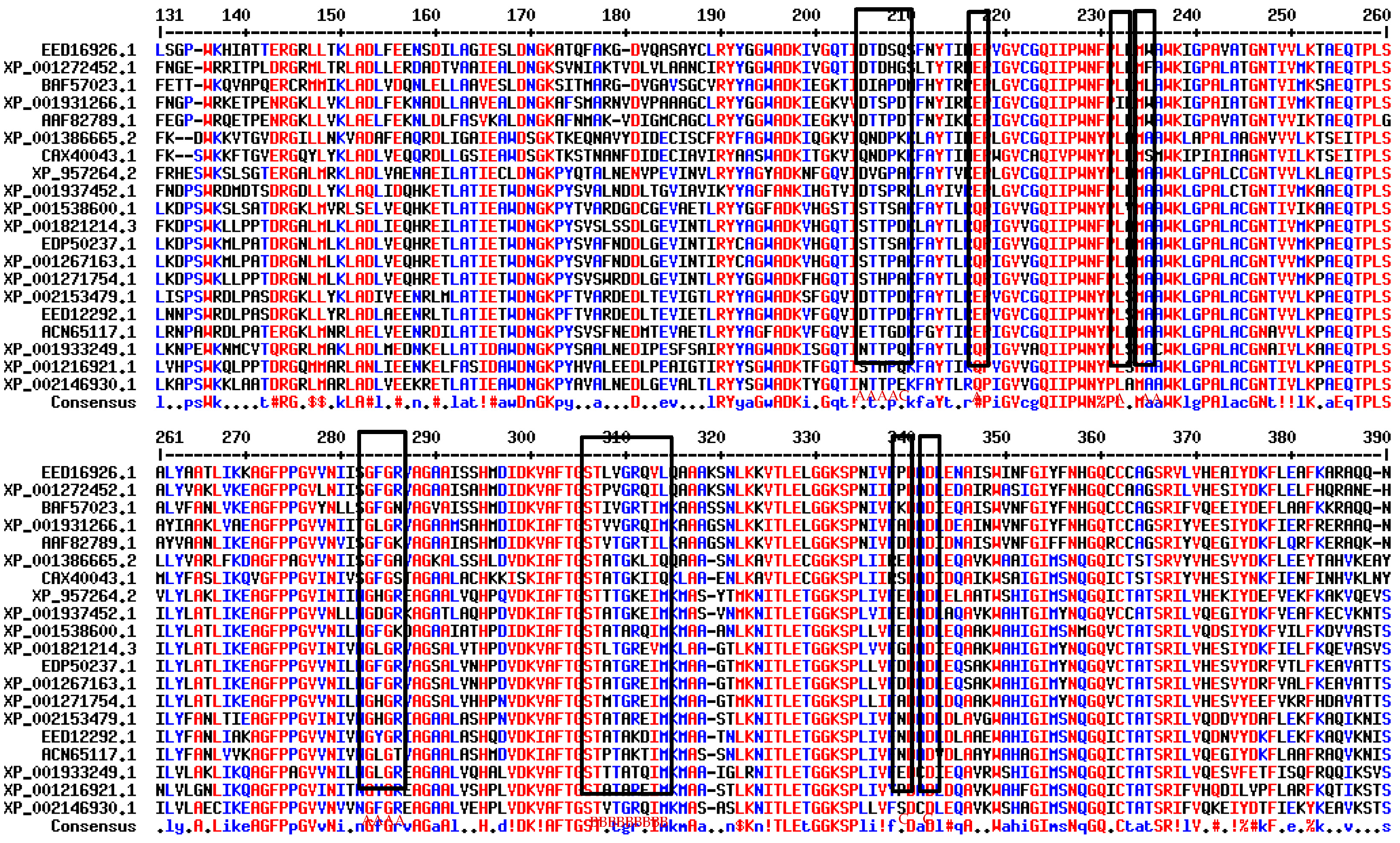
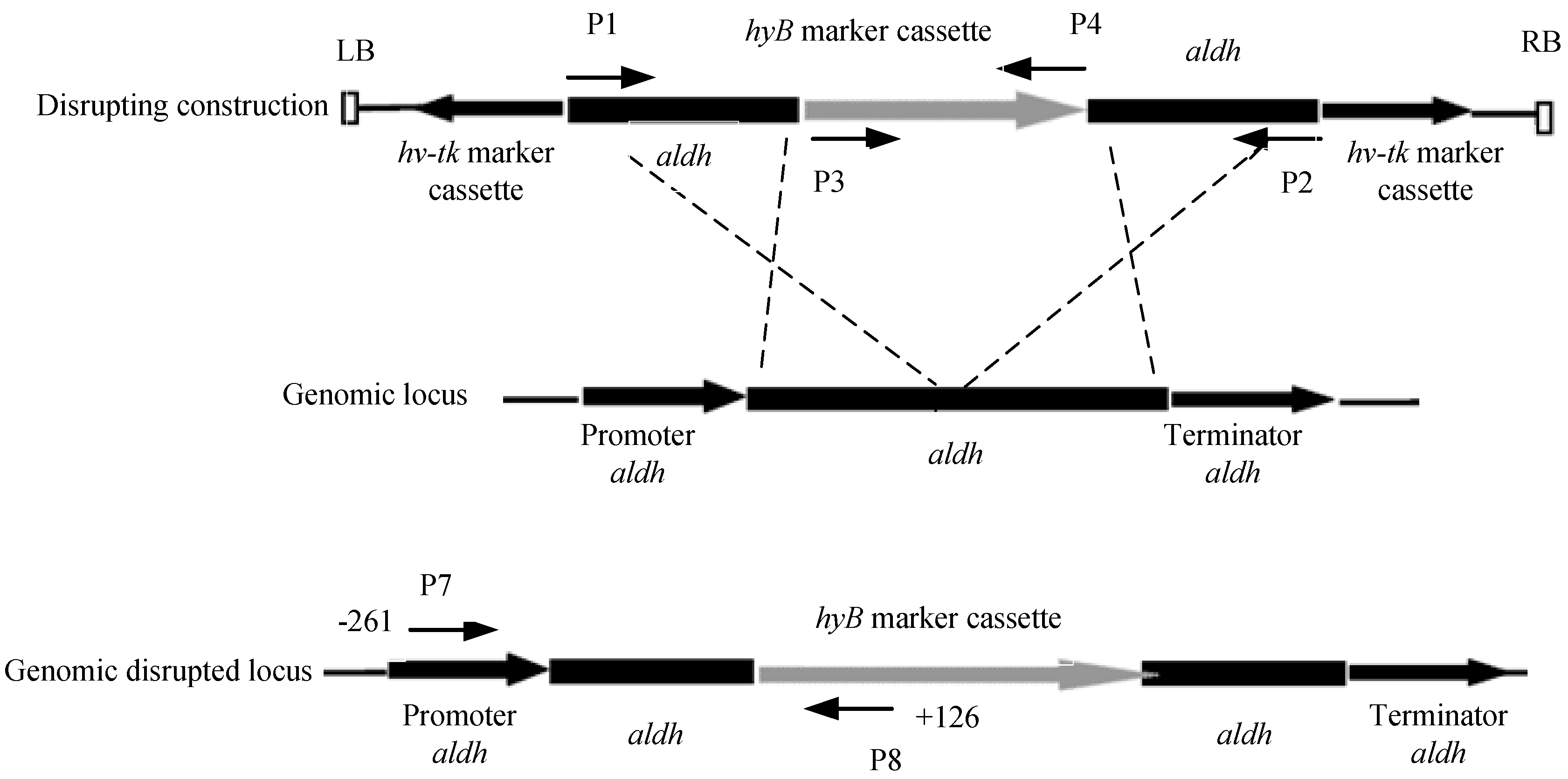
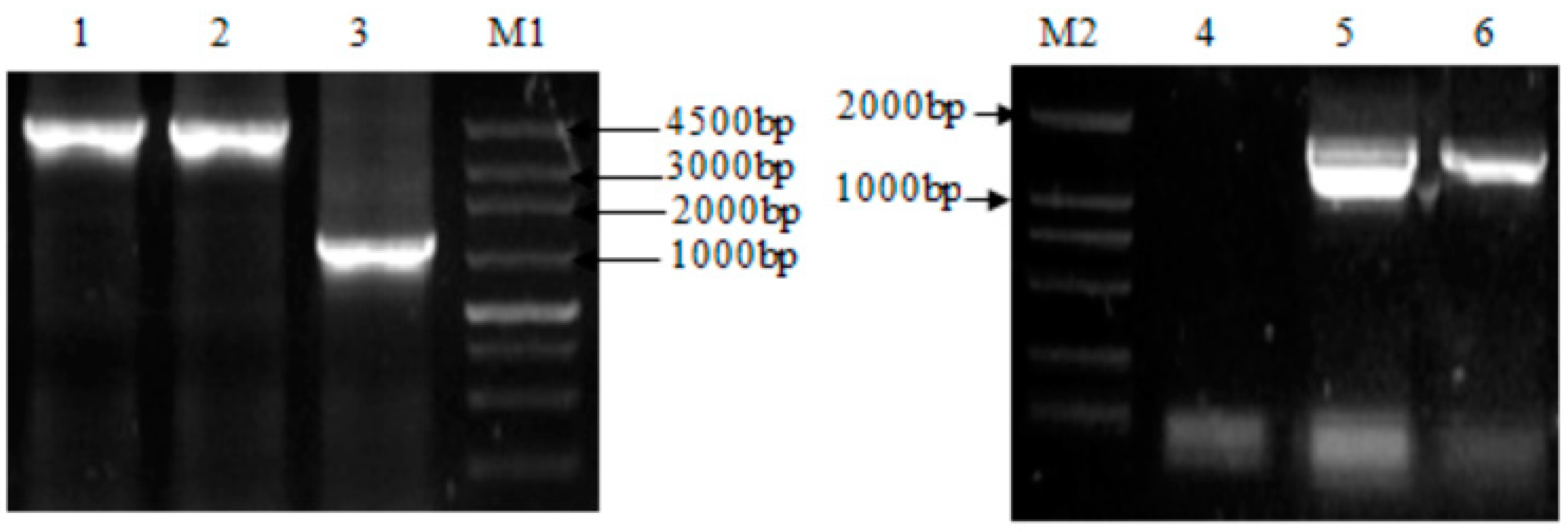
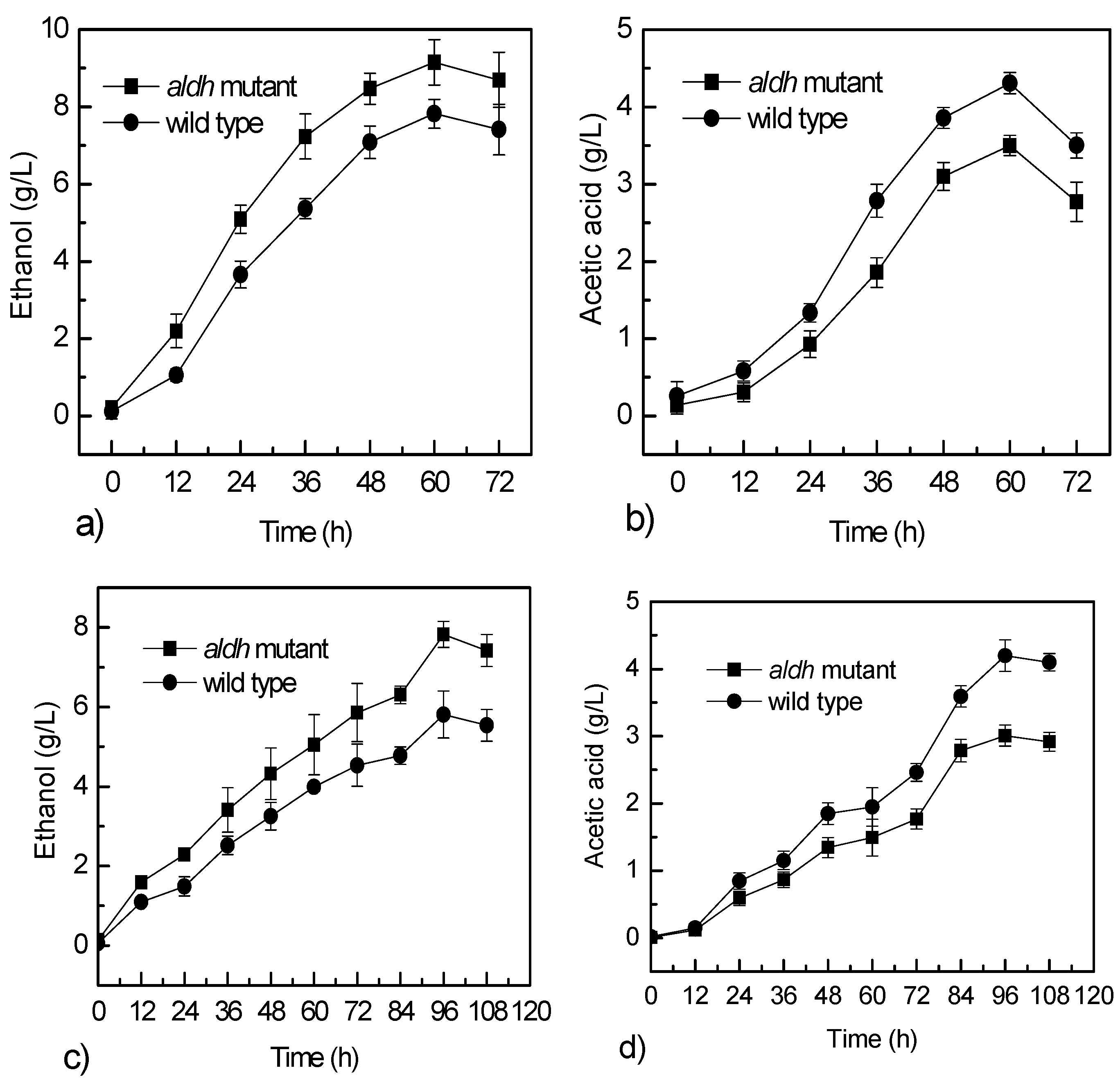

| Primer Designation | Sequence (5′-3′) | Restricted Enzyme |
|---|---|---|
| P1 | 5′CCGGAATTCCGAATCATCATACATCCACAATG3′ | EcoRI |
| P2 | 5′CGGGATCCGAGTATTTTGGTACAGATAGACC3′ | BamHI |
| P3 | 5′CTAGCTAGCCCCTCGAGGTCGACAGAAGATGATA3′ | NheI |
| P4 | 5′CTAGCTAGCTCCGGCGTAGAGGATCCTCTAGAAA3′ | NheI |
| P5 | 5′GGGGTACCCGAATCATCATACATCCACAATGAGTCTAG3′ | KpnI |
| P6 | 5′GGGGTACCGAGTATTTTGGTACAGATAGACCATCTTCTC3′ | KpnI |
| P7 | 5′-CGGAAGCGAGAAACATCTCCTTAT-3′ | |
| P8 | 5′-AAGCTGAAAGCACGAGATTCTTCG-3′ |
| Transformants | Hygromycin (100 μg/mL) | 5-Fluoro-2′-Deoxyuridine (10 μM) | Diameter of Colony |
|---|---|---|---|
| T1 | + | + | 2.32 |
| T2 | + | + | 2.10 |
| T3 | + | + | 1.92 |
| T4 | + | + | 1.85 |
| T5 | + | + | 1.63 |
| T6 | + | + | 1.55 |
| T7 | + | + | 1.78 |
| T8 | + | + | 1.93 |
| Strains | 0 | Hygromycin Concentration (μg/mL) | |||
|---|---|---|---|---|---|
| 25 | 50 | 75 | 100 | ||
| cs28 | + | + | - | - | - |
| cs28pCAM-Ptal-∆ald 13 | + | + | + | + | + |
| cs28pCAM-Ptal-∆ald 26 | + | + | + | + | + |
| Strains | Gene Up-Regulation/Down-Regulation | Substrates | Ethanol Yield (g/g) | Acetic Acid Yield (g/g) | Biomass (g/g) | References |
|---|---|---|---|---|---|---|
| F. oxysporum Fx13 | endo-1,4-xylanase 2 /up-regulation | Corn cob | 0.07 | - | - | [29] |
| F. oxysporum Fx13 | endo-1,4-xylanase 2 /up-regulation | Wheat bran | 0.22 | - | - | [29] |
| F. oxysporum cs28pCAM-Sctal4 | transaldolase/ up-regulation | xylose | 0.41 | 0.27 | 0.269 | [12] |
| F. oxysporum cs28pCAM-Sctal4 | transaldolase/ up-regulation | Rice straw | 0.25 | 0.16 | - | [12] |
| F. oxysporum FF11 | phosphoglucomutase and transaldolase/ up-regulation | glucose | - | - | 0.356 | [13] |
| F. oxysporum FF11 | phosphoglucomutase and transaldolase/ up-regulation | xylose | - | 0.471 | [13] | |
| F. oxysporum pSilent-1-FoPTR2-3 | peptide transporter/ down-regulation | Wheat straw | 0.04 | 0.13 | [6] | |
| F. oxysporum pBARGPE1-FoPTR2-13 | peptide transporter/ up-regulation | Wheat straw | 0.09 | - | 0.18 | [6] |
| F. oxysporum pBARGPE1-FoPTR2-13 | peptide transporter/ up-regulation | glucose | 0.4 | - | [6] | |
| F. oxysporum pBARGPE1-FoPTR2-13, | peptide transporter/ up-regulation | xylose | 0.25 | - | [6] | |
| F. oxysporum pBARGPE1-Hxt-6 | high affinity glucose transporter/ up-regulation | glucose | 0.4 | - | [10] | |
| F. oxysporum pBARGPE1-Hxt-6 | high affinity glucose transporter/ up-regulation | xylose | 0.32 | - | [10] | |
| F. oxysporum cs28pCAM-Pstal-∆aldh | aldehyde dehydrogenase/ down-regulation | glucose | 0.45 | 0.175 | 0.202 | The presentstudy |
| F. oxysporum cs28pCAM-Pstal-∆aldh | aldehyde dehydrogenase/ down-regulation | xylose | 0.39 | 0.15 | 0.226 | The presentstudy |
Disclaimer/Publisher’s Note: The statements, opinions and data contained in all publications are solely those of the individual author(s) and contributor(s) and not of MDPI and/or the editor(s). MDPI and/or the editor(s) disclaim responsibility for any injury to people or property resulting from any ideas, methods, instructions or products referred to in the content. |
© 2022 by the authors. Licensee MDPI, Basel, Switzerland. This article is an open access article distributed under the terms and conditions of the Creative Commons Attribution (CC BY) license (https://creativecommons.org/licenses/by/4.0/).
Share and Cite
Fan, J.; Huang, X.; Zheng, G.; Liu, C.; Wang, M.; Sun, Y.; Yang, Q. Knockout of the Aldehyde Dehydrogenase Gene in Fusarium oxysporum for Enhanced Ethanol Yield. Energies 2023, 16, 427. https://doi.org/10.3390/en16010427
Fan J, Huang X, Zheng G, Liu C, Wang M, Sun Y, Yang Q. Knockout of the Aldehyde Dehydrogenase Gene in Fusarium oxysporum for Enhanced Ethanol Yield. Energies. 2023; 16(1):427. https://doi.org/10.3390/en16010427
Chicago/Turabian StyleFan, Jinxia, Xiaomei Huang, Guoxiang Zheng, Changyu Liu, Ming Wang, Yong Sun, and Qian Yang. 2023. "Knockout of the Aldehyde Dehydrogenase Gene in Fusarium oxysporum for Enhanced Ethanol Yield" Energies 16, no. 1: 427. https://doi.org/10.3390/en16010427
APA StyleFan, J., Huang, X., Zheng, G., Liu, C., Wang, M., Sun, Y., & Yang, Q. (2023). Knockout of the Aldehyde Dehydrogenase Gene in Fusarium oxysporum for Enhanced Ethanol Yield. Energies, 16(1), 427. https://doi.org/10.3390/en16010427







